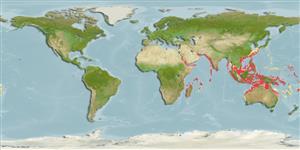Environment: milieu / climate zone / depth range / distribution range
Ecology
Marine; demersal; depth range 50 - 120 m (Ref. 42740). Tropical
Indo-West Pacific: Persian Gulf to the continental shelf of Asia, the Philippines, Indonesia, and northwestern Australia.
Size / Weight / Age
Maturity: Lm ? range ? - ? cm
Max length : 27.0 cm TL male/unsexed; (Ref. 11441)
Dorsal spines (total): 5; Dorsal soft rays (total): 22; Anal spines: 1; Anal soft rays: 18 - 19. Light red dorsally, shading to white ventrally, the scale edges brown except ventrally. Two longitudinal rows of indistinct light red blotches on body, ending in 2 dark red spots on base of caudal fin. Snout light blue with oblique yellow lines. Eye not very large, its diameter more than 4 times in head length of adults. Third and fourth dorsal-fin spine longest. Last interspinous membrane of dorsal fin connected to base of first soft ray (Ref 42740).
A coastal species (Ref. 42740) found in trawling grounds.
Life cycle and mating behavior
Maturity | Reproduction | Spawning | Eggs | Fecundity | Larvae
Allen, G.R. and R. Swainston, 1988. The marine fishes of north-western Australia: a field guide for anglers and divers. Western Australian Museum, Perth. 201 p. (Ref. 3132)
IUCN Red List Status (Ref. 130435: Version 2024-2)
Threat to humans
Harmless
Human uses
Tools
Special reports
Download XML
Internet sources
Estimates based on models
Preferred temperature (Ref.
123201): 22.4 - 28.1, mean 26.1 °C (based on 401 cells).
Phylogenetic diversity index (Ref.
82804): PD
50 = 0.5000 [Uniqueness, from 0.5 = low to 2.0 = high].
Bayesian length-weight: a=0.00724 (0.00414 - 0.01268), b=3.06 (2.91 - 3.21), in cm total length, based on LWR estimates for this species & Genus-body shape (Ref.
93245).
Trophic level (Ref.
69278): 3.6 ±0.4 se; based on size and trophs of closest relatives
Resilience (Ref.
120179): Medium, minimum population doubling time 1.4 - 4.4 years (Preliminary K or Fecundity.).
Fishing Vulnerability (Ref.
59153): Low vulnerability (17 of 100).
